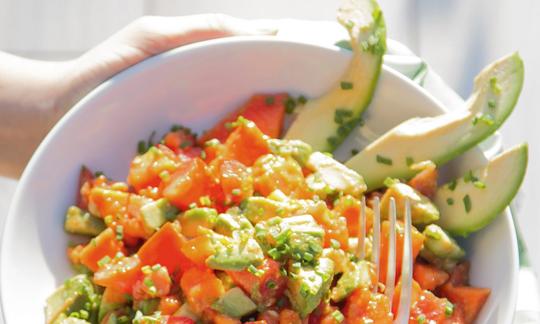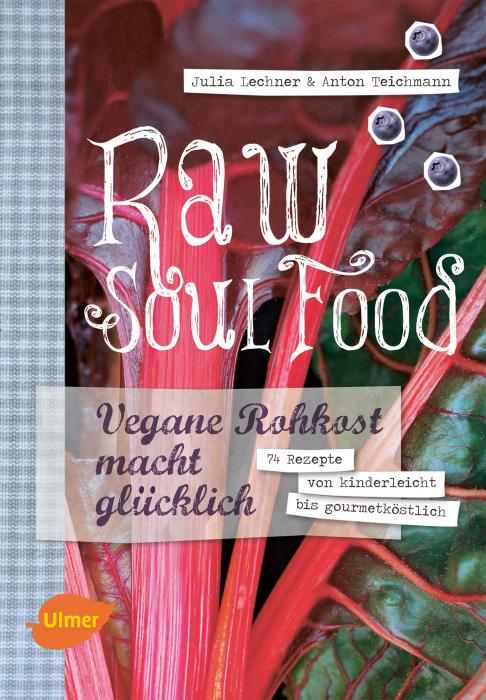Papaya a la Mexicana with avocados
vegan
Ingredients (for servings, )
| For the salad base | |
|---|---|
| 1 kg | Papaya, raw (organic?) (35 oz) |
| 2 | Avocados, raw (organic?) (14 oz) |
| 6 | Tomatoes, raw (organic?) (26 oz) |
| Seasoning | |
| 2 tbsp chopped | Chives, raw (organic?) (0.21 oz) |
| 1 dash | Paprika powder, sweet (raw?, organic?) (0.00 oz) |
| 1 dash | Cinnamon (ground, raw, organic?) (0.00 oz) |
| oz | Reduced salt soy sauce (Genen-Shoyu, organic?, raw?) |
Type of preparation
- food preparation without heating
Preparation
For the salad basis
Peel the papaya(s), remove the seeds, and then cut into cubes.For 1 kilogram papaya, you will need either about one large or three small papayas.
Cube the avocados and tomatoes and add to the papaya in a large bowl.
Seasoning
Finely slice the chives and add to the other ingredients in the bowl. Mix well and serve.We use a low-salt variety soy sauce called genen shoyu whereas the original recipe calls for the gluten-free soy sauce tamari.
|
Nutritional Information per person
Convert per 100g
|
2000 kcal | |
|---|---|---|
| Energy | 403 kcal | 20.1% |
| Fat/Lipids | 21 g | 30.0% |
| Saturated Fats | 3.2 g | 16.0% |
| Carbohydrates (inc.dietary fiber) | 57 g | 21.2% |
| Sugars | 33 g | 37.2% |
| Fiber | 18 g | 70.7% |
| Protein/Albumin | 6.5 g | 13.0% |
| Cooking Salt (Na:53.7 mg) | 136 mg | 5.7% |
| Essential micronutrients with the highest proportions | per person | 2000 kcal | |
|---|---|---|---|
| Vit | Vitamin C (ascorbic acid) | 251 mg | 314.0% |
| Vit | Vitamin B9, B11 (Folate, as the active form of folic acid) | 271 µg | 135.0% |
| Elem | Potassium, K | 1'846 mg | 92.0% |
| Vit | Vitamin K | 61 µg | 81.0% |
| Min | Copper, Cu | 0.55 mg | 55.0% |
| Vit | Vitamin B6 (pyridoxine) | 0.67 mg | 48.0% |
| Vit | Vitamin B5 (Pantothenic acid) | 2.7 mg | 45.0% |
| Vit | Vitamin E, as a-TEs | 5.1 mg | 43.0% |
| Elem | Magnesium, Mg | 137 mg | 36.0% |
| Vit | Vitamin A, as RAE | 276 µg | 34.0% |
Detailed Nutritional Information per Person for this Recipe
The majority of the nutritional information comes from the USDA (US Department of Agriculture). This means that the information for natural products is often incomplete or only given within broader categories, whereas in most cases products made from these have more complete information displayed.
If we take flaxseed, for example, the important essential amino acid ALA (omega-3) is only included in an overarching category whereas for flaxseed oil ALA is listed specifically. In time, we will be able to change this, but it will require a lot of work. An “i” appears behind ingredients that have been adjusted and an explanation appears when you hover over this symbol.
For Erb Muesli, the original calculations resulted in 48 % of the daily requirement of ALA — but with the correction, we see that the muesli actually covers >100 % of the necessary recommendation for the omega-3 fatty acid ALA. Our goal is to eventually be able to compare the nutritional value of our recipes with those that are used in conventional western lifestyles.
| Essential fatty acids | per person | 2000 kcal |
|---|---|---|
| Linoleic acid; LA; 18:2 omega-6 | 2.5 g | 25.0% |
| Alpha-Linolenic acid; ALA; 18:3 omega-3 | 0.31 g | 16.0% |
| Essential amino acids | per person | 2000 kcal |
|---|---|---|
| Tryptophan (Trp, W) | 0.08 g | 31.0% |
| Threonine (Thr, T) | 0.20 g | 22.0% |
| Lysine (Lys, K) | 0.33 g | 18.0% |
| Isoleucine (Ile, I) | 0.19 g | 15.0% |
| Phenylalanine (Phe, F) | 0.23 g | 15.0% |
| Valine (Val, V) | 0.22 g | 14.0% |
| Leucine (Leu, L) | 0.31 g | 13.0% |
| Methionine (Met, M) | 0.07 g | 8.0% |
| Vitamins | per person | 2000 kcal |
|---|---|---|
| Vitamin C (ascorbic acid) | 251 mg | 314.0% |
| Vitamin B9, B11 (Folate, as the active form of folic acid) | 271 µg | 135.0% |
| Vitamin K | 61 µg | 81.0% |
| Vitamin B6 (pyridoxine) | 0.67 mg | 48.0% |
| Vitamin B5 (Pantothenic acid) | 2.7 mg | 45.0% |
| Vitamin E, as a-TEs | 5.1 mg | 43.0% |
| Vitamin A, as RAE | 276 µg | 34.0% |
| Vitamin B3 (Niacin) | 5.0 mg | 31.0% |
| Vitamin B1 (Thiamine) | 0.26 mg | 24.0% |
| Vitamin B2 (Riboflavin) | 0.31 mg | 22.0% |
| Vitamin B7 (Biotin, ex vitamin H) | 9.8 µg | 20.0% |
| Essential macroelements (macronutrients) | per person | 2000 kcal |
|---|---|---|
| Potassium, K | 1'846 mg | 92.0% |
| Magnesium, Mg | 137 mg | 36.0% |
| Phosphorus, P | 163 mg | 23.0% |
| Calcium, Ca | 110 mg | 14.0% |
| Sodium, Na | 54 mg | 7.0% |
| Essential trace elements (micronutrients) | per person | 2000 kcal |
|---|---|---|
| Copper, Cu | 0.55 mg | 55.0% |
| Manganese, Mn | 0.62 mg | 31.0% |
| Iron, Fe | 2.3 mg | 16.0% |
| Zinc, Zn | 1.6 mg | 16.0% |
| Selenium, Se | 2.6 µg | 5.0% |
| Iod, I (Jod, J) | 2.7 µg | 2.0% |
| Fluorine, F | 15 µg | < 0.1% |
The cookbook "Raw Soul Food - Vegan Raw Food Makes You Happy" shows how you can prepare amazingly versatile dishes using this method of preparation.
Since this book is written in German, a description is omitted here. If you are interested, please switch to German in the menu.
This fruity papaya salad is not only refreshing and delicious but also very healthy thanks to the combination of essential fatty acids and vitamins it contains.
Servings: The original recipe is intended for 2 servings but since 500 grams of papaya and 1 avocado are a lot for one person, we have set this dish for 3 servings. If you would like to serve it as a side or a snack, then the recipe as is should make enough for 6 to 8 servings.
Avocados and fat content: Avocados are healthy but also rich in fat. They contain large amounts of monounsaturated fatty acids, which explains why this dish has a relatively high fat content.
We don’t consider soy sauce to be raw. Soybeans are generally heated during the production process since green beans of all types contain the glycoprotein phasin, which is toxic for humans. Phasin inhibits the absorption of nutrients in the intestine, causes hemagglutination (clumping of the red blood cells), and in larger amounts can destroy the intestinal villi. Heating processes (e.g., cooking and roasting) destroy phasin and make soybeans and soybean products such as tofu, miso, and tempeh edible for humans. As a result, even unpasteurized soy products are not actually raw, but are instead cooked products that have been “revived” through the process of fermentation.
This information should help you understand why we label this recipe as vegan cooked food even though it is listed as raw food in the cookbook it comes from.
Papaya: A papaya contains up to 85% water and is therefore very low in calories. Papayas are known for their enzymes that degrade proteins, most notably papain. Papain is thought to promote digestion and act a bit like a laxative.
As a result, it is often an ingredient in medicinal products used to treat digestive problems connected to a reduced ability to digest protein. In contrast to pepsin, which needs to be in the acidic environment of the stomach to be activated, papain is also active in alkaline environments. As a result, papaya seeds can be ground and used to tenderize meat. In addition, papaya contains high amounts of vitamin C. According to the European RDA (Recommended Dietary Allowance), 100 g covers ¾ of the vitamin C requirement, whereby individual needs should be taken into consideration.
Tip from the author on preparing avocados: “It is easier to peel an avocado if you first cut it in half lengthwise. Then remove the pit and cut both halves in half again. Now you can easily peel the skin off of each piece.”
Preventing avocados from turning brown: When avocados are cut open, the cell walls at the cut are broken, which initiates the oxidation process. The avocado then turns brown if nothing is done to prevent this natural process. To keep this from happening, you can drizzle lemon or lime juice on the avocados, which also tastes good in the salad.
Storing avocados: Avocados are harvested before they are ripe. They ripen best if you place them next to apples (or put them together in a paper bag) and store at room temperature. The apples release ethylene gas, which speeds up the ripening process.
Spiciness: If you like spicy dishes, you can add chopped chili peppers and black pepper. Cilantro is a perfect finishing touch for this dish.




